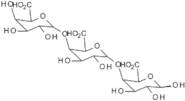
Trigalacturonic acid
CAS : 6037-45-2
Ref. 3D-OT02431
| 2mg | 136,00 € | ||
| 5mg | 180,00 € | ||
| 10mg | 260,00 € | ||
| 25mg | 452,00 € | ||
| 50mg | 835,00 € |
Informations sur le produit
- Gal-α-1,4-Gal-α-1,4-GalA
- <span class="text-smallcaps">D</smallcap>-Galacturonic acid, O-α-<smallcap>D</smallcap>-galactopyranuronosyl-(1→4)-O-α-<smallcap>D</span>-galactopyranuronosyl-(1→4)-
- Galacturonic acid, O-α-<span class="text-smallcaps">D</smallcap>-galactopyranuronosyl-(1→4)-O-α-<smallcap>D</span>-galactopyranuronosyl-(1→4)-
- Hexopyranuronosyl-(1->4)Hexopyranuronosyl-(1->4)Hexuronic Acid
- O-α-<span class="text-smallcaps">D</smallcap>-Galactopyranuronosyl-(1→4)-O-α-<smallcap>D</smallcap>-galactopyranuronosyl-(1→4)-<smallcap>D</span>-galacturonic acid
- O-α-D-Galactopyranuronosyl-(1→4)-O-α-D-galactopyranuronosyl-(1→4)-D-galacturonic acid
- D-Galacturonic acid, O-α-D-galactopyranuronosyl-(1→4)-O-α-D-galactopyranuronosyl-(1→4)-
- Galacturonic acid, O-α-D-galactopyranuronosyl-(1→4)-O-α-D-galactopyranuronosyl-(1→4)-
Trigalacturonic acid, (α-1,4 galacturonotriose) is derived from pectin or pectic acid by enzymatic or partial acid hydrolysis (Combo, 2012). It is used inâ¯galacturonic acidâ¯metabolism research as a substrate to identify, differentiate, and characterize endo- and exopolygalacturonase(s), and gluconase(s) (Jayani, 2005). The addition of very short fragments of homogalacturonan, tri-galacturonate, and tetra-galacturonate oligosaccharides, restores development in dark-grown, de-etiolated seedling mutants, suggesting that they are unable to generate de-methylesterified pectin fragments. A model of spatiotemporally separated photoreceptive and signal-responsive cell types has been proposed, that contains overlapping subsets of the regulatory network of light-dependent seedling development (Sinclair, 2017).
Propriétés chimiques
Question d’ordre technique sur : 3D-OT02431 Trigalacturonic acid
Si vous souhaitez demander un devis ou passer commande, veuillez plutôt ajouter les produits souhaités à votre panier, puis demander un devis ou passer commande à partir de votre panier. C'est une méthode plus rapide, plus économique, et vous pourrez bénéficier des remises disponibles ainsi que d'autres avantages





